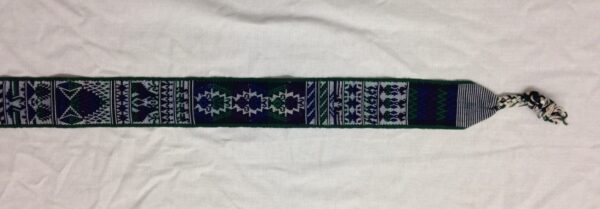Maya textiles are highly celebrated not only for their bright colors and their diversity, but also for their rich traditions, long history, and how they unite the many different sub-cultures of the Maya people. The textile artisans are traditionally women, and these women have passed on their traditions to their daughters and granddaughters for centuries. The Maya use many different dyeing, weaving, and decorating techniques, including ikat, gauze weaving, embroidery, and brocading. The artisans have also developed a wide variety of designs and motifs, some of which are used throughout the Maya region, while others are exclusive to a specific community. These designs and motifs serve both as symbols of their specific communities and of their general Maya identity.
Maya people today often wear Western contemporary clothing as daily wear. However, because the tourist trade has helped to revive interest in Maya culture, artisans make a great deal of Maya clothing to sell as a way to support their families; this trade has served as a strong motivation to revive, cultivate, and perpetuate traditional Maya textile artistry. Today the Maya continue to make and wear traditional clothing for special occasions, and they are increasingly wearing traditional clothing as a political symbol of their heritage.

Maya culture, San Miguel Totonicapan
20th century
Cotton and pigment, L. 90.5 mm x W. 1 mm x H. 1.5 m
Ballweg collection #1972.19
Ikat is a type of cloth made using yarn that has been pre-dyed with patterns that create pleasingly abstracted designs in the final woven garment. While the making of ikat is relatively rare today, the Maya community of San Miguel Totonicapan continues to produce this cloth, and its artisans are celebrated for their especially skilled and beautiful designs. Ikat cloth is traditionally used for practical clothing such as this skirt, which has black and white designs of human figures, floral motifs, and geometric designs. Researched by Kari Mishler

Maya culture
20th century
Cotton, L. 32.5 cm x W. 1 mm x H. 88 cm
Ballweg collection #1972.33
A tapados is a loosely woven garment that is typically wrapped around the head. One effective method for creating such a garment is gauze weaving, as shown in this tapados with the common motifs of humans, donkeys, and floral images. Gauze weaving uses a fine, delicate base (warp) yarn that is brocaded with yarns of different densities and using different types of loose and tight stitches to create an elaborate but monochromatic design. This technique creates a very lightweight textile that is appropriate for warm Maya lowland regions, typically used for tapados as well as for traditional Maya blouses known as huipils. Researched by Kari Mishler




Maya culture
20th century
Cotton and pigments, L. 2.23 m x W. 1 mm x H. 6.5 cm
Ballweg collection #1972.69

Maya culture
20th century
Cotton and pigments, L. 1.27 m x W. 1 mm x H. 9 cm
Ballweg collection #1972.61
Maya belts are often highly decorative articles of clothing that incorporate bright colors and designs using both brocade and embroidery. Brocade is the technique of creating detailed textile designs using different colored weft threads while weaving the textile, while embroidery involves sewing colorful designs onto the surface of the woven textile. Maya artisans have especially developed the art of brocade–the more difficult and complex technique–and each individual community proudly displays its individual styles and patterns of brocade in women’s huipil blouses and in both men’s and women’s belts.
These two brightly colored belts have been embellished with traditional bold geometric designs as well as fanciful images of humans, animals, and plants, including rabbits, birds, maize plants, and flowers. These figural motifs are also meaningful, however, as these animals and plants figure prominently in ancient Maya mythology. Researched by Kari Mishler

Maya culture
20th century
Cotton and pigments, L. 4.36 m x W. 2.5 cm x H. 2.5 cm
Ballweg collection #1972.45
The tupui is a traditional hair ornament used by the Maya women of Cobán, Guatemala. The name tupui means “coral snake,” so named because the hair wrap is red and very long, measuring over four meters. The tupui is used to wrap a woman’s hair into a thick cone, with the tassels left to hang down from the back of the hairstyle. While predominantly used for traditional, formal ceremony today, the tupui may also be worn daily by high-status Cobán Maya women. Researched by Kari Mishler
For more information, you may contact the researcher(s) noted in the title of this exhibit entry, or Dr. Billie Follensbee, the professor of the course, at BillieFollensbee@MissouriState.edu

